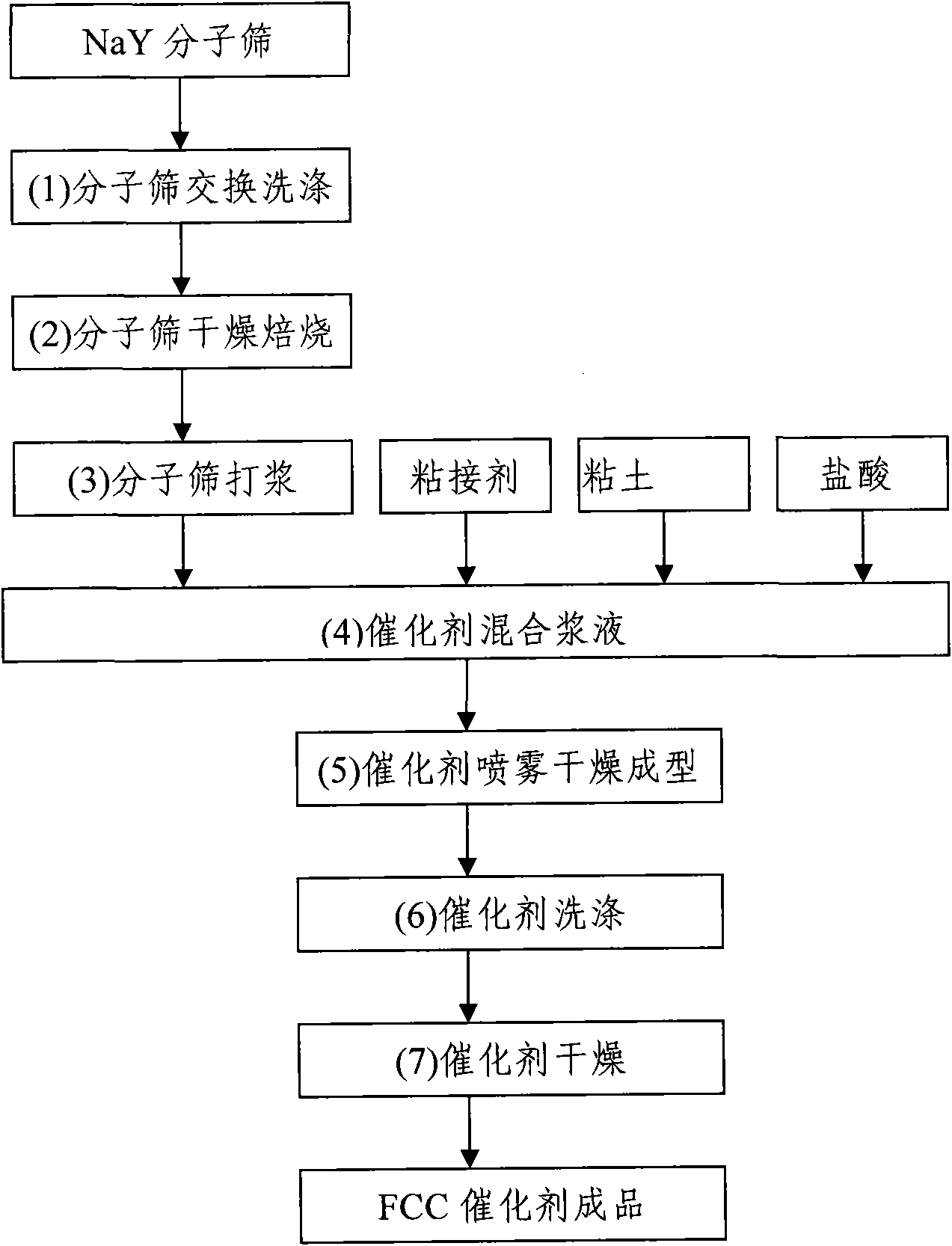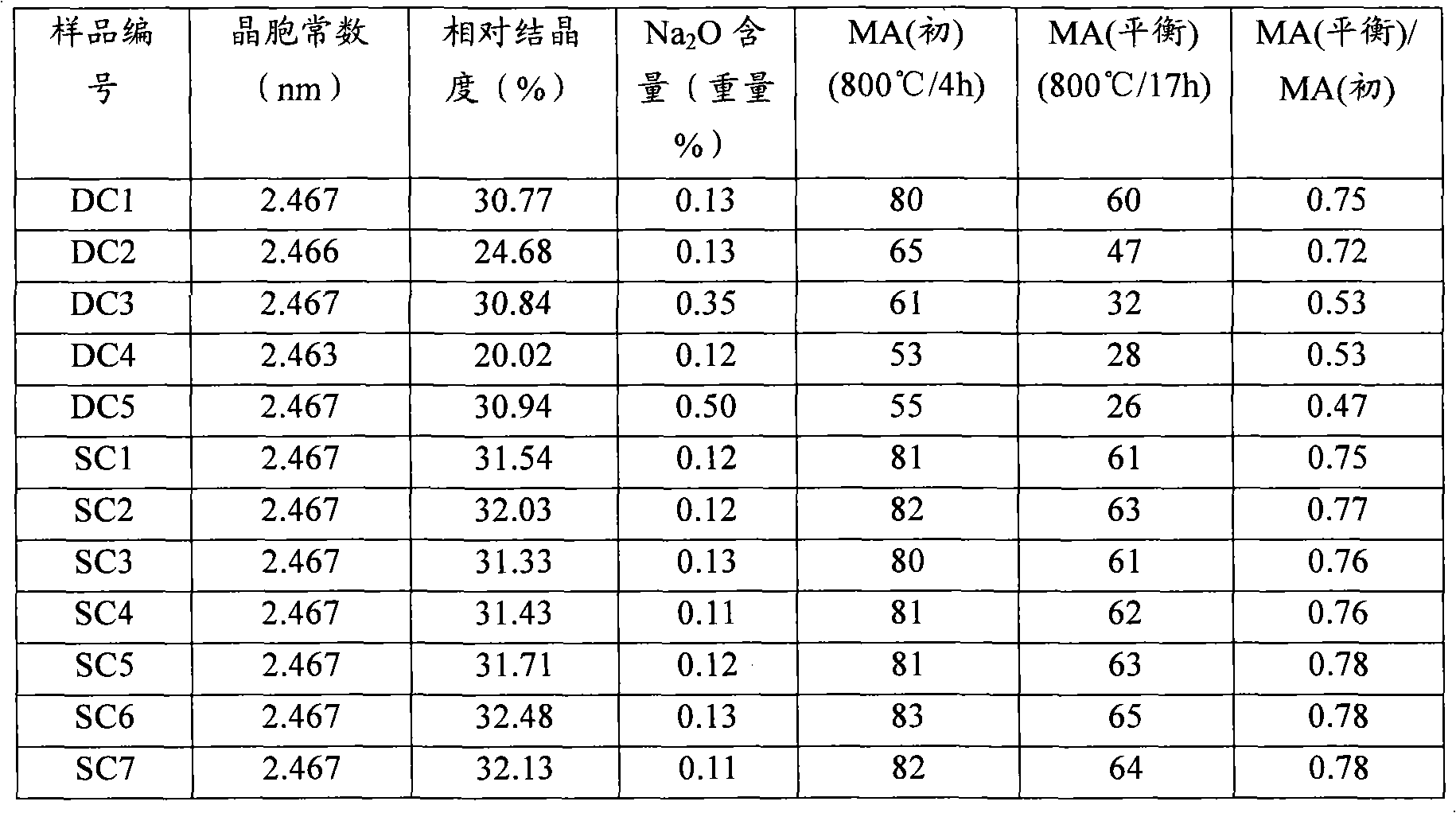Method for reducing ammonium and nitrogen consumption in FCC (Fluid Catalytic Cracking) catalyst production process
A catalyst and catalyst particle technology, applied in molecular sieve catalysts, chemical instruments and methods, chemical/physical processes, etc., can solve problems such as ammonium nitrogen pollution, reduce the amount of ammonium nitrogen, reduce water consumption, and ensure the effect of washing effect.
- Summary
- Abstract
- Description
- Claims
- Application Information
AI Technical Summary
Problems solved by technology
Method used
Image
Examples
preparation example Construction
[0017] In the preparation method of the FCC catalyst provided by the present invention, during the molecular sieve exchange process, the molecular sieve is contacted with the acid solution for 0.5-3 hours, and then separated, and the steps of washing, drying and roasting the separated molecular sieve can also be included. The methods of separation, washing, drying and roasting are well known to those skilled in the art. For example, the separation can be done by filtering to separate the exchanged molecular sieve from the mother liquor; the molecular sieve can be washed with deionized water.
[0018] In the preparation method of the FCC catalyst provided by the invention, in the washing step of the catalyst, the catalyst particle containing the exchanged molecular sieve is contacted with an acid solution to carry out the washing reaction, so as to reduce the content of sodium oxide in the catalyst. Wherein, the acid solution includes inorganic acid and organic acid, and the ino...
Embodiment 1
[0028] The preparation of present embodiment FCC catalyst comprises the following steps:
[0029] (1) Exchange washing of NaY molecular sieve: take by weighing 4.48 kilograms of citric acid and add appropriate amount of cold water and stir to make it dissolve, then add concentration and be 8.1 kilograms of hydrochloric acid of 36% by weight, then continue to add cold water to dilute the solution to 1000L and be made into H + Acid solution with a molar concentration of 0.15M (M is mol / L, in which the concentration of citric acid is 0.07M and the concentration of hydrochloric acid is 0.08M). kg, then stirred and reacted at 3±0.5°C for 1.5 hours, filtered, washed with deionized water, and the amount of washing water was 10 times the weight of the molecular sieve;
[0030] (2) flash drying the product of step (1) and roasting at 550° C. for 3 hours;
[0031] (3) preparing molecular sieve slurry by beating the product of step (2) according to the ratio of molecular sieve dry basis...
Embodiment 2
[0038] Prepare FCC catalyst by the method described in embodiment 1, difference is step (1) and step (6).
[0039] (1) The exchange washing of NaY molecular sieve: take by weighing 9.45 kilograms of oxalic acid, add appropriate amount of cold water and stir to make it dissolve, add concentration and be 5 kilograms of hydrochloric acid of 36% by weight, then continue to add cold water and dilute the solution to 1000L and be made into H + Acid solution with a molar concentration of 0.20M, control the solution temperature: 2±0.5°C, add 100 kg of NaY molecular sieve (dry basis) under stirring, then stir at 2±0.5°C for 2.0 hours, then filter the slurry, filter cake Rinse with deionized water 10 times the weight of molecular sieve;
[0040] (6) Catalyst washing: take by weighing 380 kilograms of oxalic acid and add appropriate amount of cold water and stir to make it dissolve, then add 1000 grams of hydrochloric acid with a concentration of 36% by weight, then continue to add cold w...
PUM
 Login to View More
Login to View More Abstract
Description
Claims
Application Information
 Login to View More
Login to View More - R&D
- Intellectual Property
- Life Sciences
- Materials
- Tech Scout
- Unparalleled Data Quality
- Higher Quality Content
- 60% Fewer Hallucinations
Browse by: Latest US Patents, China's latest patents, Technical Efficacy Thesaurus, Application Domain, Technology Topic, Popular Technical Reports.
© 2025 PatSnap. All rights reserved.Legal|Privacy policy|Modern Slavery Act Transparency Statement|Sitemap|About US| Contact US: help@patsnap.com


